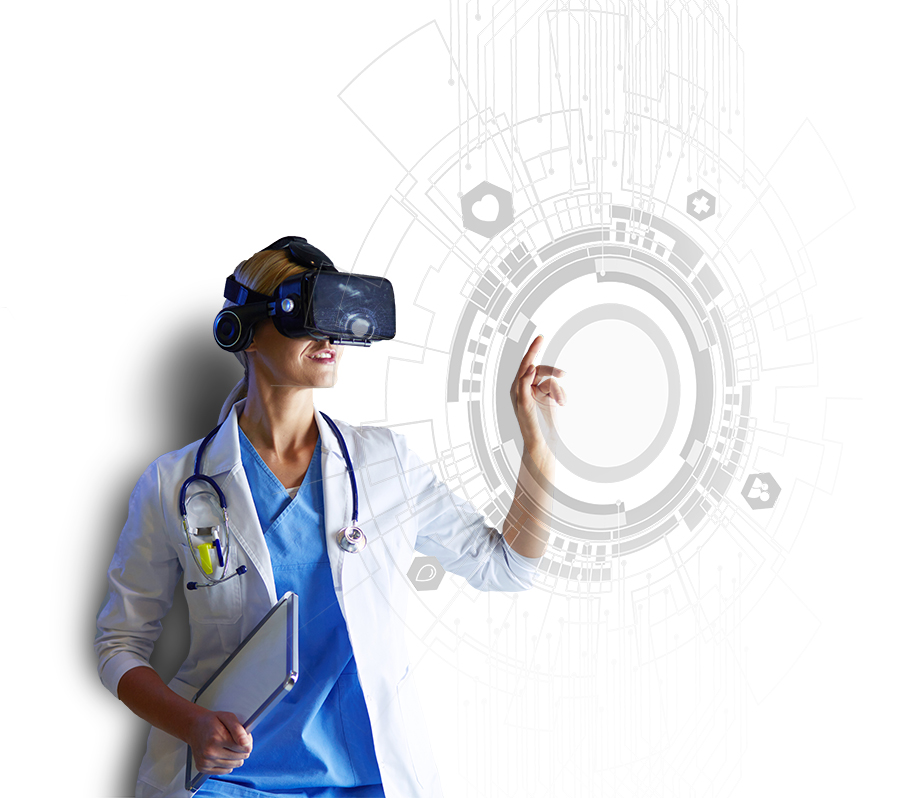The reality of VR
How virtual reality can help disrupt the health-care industry
Story: Melanie Hudson
Virtual reality is no longer science fiction. During the past few decades, massive strides in technology have prompted head-mounted virtual reality hardware to truly immerse users in three-dimensional worlds, with products like Facebook’s Oculus Rift and Google Cardboard transporting users to both augmented realities and fabricated fantasies.
Virtual becoming reality
However, virtual reality is on course to alter more than digital lives. It may very well alter everyday tasks; perhaps even how daily work is done. Remote work is becoming more common, and millennials entering the workforce are expediting it. Engineers now toy with the idea of a physical workplace that comprises virtual workers all utilizing head-mounted displays to participate in virtual reality. Students at the University of Pennsylvania created a robot named DORA, for Dexterous Observational Roving Automaton, that acts as an out-of-body host for VR users.
AI and health care
Those applications were only the beginning, however. There are even more exciting applications that involve health care. Artificial intelligence has made a sizeable impact on the industry with incredible advancements in deep learning. Previously unimaginable feats, such as automated diagnosis and accelerated research of big data, are now realities for doctors and patients who adopt and use artificial intelligence in treatment. Mobile applications like Sense.ly empowered telemedicine, for instance. This app is a solution for those with chronic pain or illnesses that requires constant attention.
Rethinking medical training
The average cost of attending medical school in the United States is around $32,000 per year, according to U.S. News & World Report. Training medical students is an exorbitantly expensive affair. Using telerobotics could cut costs and reduce risk. Some partnerships, such as Next Galaxy Corp. and VR HealthNet, have jump-started the use of VR in medical training. Their technology allows students to perform virtual procedures in safe and controlled settings. “We have developed a strong expertise in applying the principles of virtual reality to augment the training of health-care professionals in order to improve patient outcomes and reduce cost,” says President Mary Spio, of Next Galaxy in a news release announcing their partnership. “We look forward to initially deploying our virtual reality solutions at long-term care facilities and offering a solution to the costly training problem, and at the same time greatly improving the quality of care,” adds CEO Dr. Suresh Nellore, of VR HealthNet.
Reimagining surgeries
Virtual reality is simply making its exponential growth a possibility. Robotic surgeries coupled with VR allow surgeons, much like the workers using DORA, to take control of a robotic entity and use it as a shell to perform the procedures. In addition to telerobotic surgery, VR helps train surgeons to use VR and robotic technologies most effectively, in a simulated and safe, no-risk setting.
Repairing mental illness
The benefits of virtual reality on patients suffering from post-traumatic stress disorder (PTSD) are well documented. VR immerses patients in real-world settings, where they must encounter uncomfortable decisions and situations again and again. This may seem cruel, but, in actuality, exposure therapy has been the most effective treatment for those suffering from trauma or battling anxiety disorders. Reliving past combat traumas with the sense of agency found in VR can ameliorate feelings of guilt and powerlessness in soldiers, for example. Traditional video games were proven to lessen symptoms of severe trauma, but clinical VR goes further and weakens the strength of the symptoms of combat-related PTSD. The effectiveness is intensified because it’s available all the time to provider a wider, most cost-effective treatment.
Conclusion
There are innumerable ways VR will impact how treatment is administered and diseases diagnosed. It may even shape how new doctors are educated and continue education for senior health-care professionals. It’s primed to change how medical students are trained, vastly reducing costs. Its use could be more effective to treat mental health issues such as phobias and PTSD. Preventive medicine also could be overhauled, making checking in with doctors, nurses, and nutritionists as easy as pressing a button on your smartwatch or using an app.
VR could reshape not only the way we interact with health care, but the way we understand it, too. Companies like Google and Facebook invested billions into VR collectively. As companies such as Sense.ly and VR HealthNet more aggressively integrate cutting-edge technologies, there may be no need to imagine it at all.
About the writer
Melanie Hudson is a financial valuation analyst who has directly executed and advised on transactions across real estate, private equity, public equity, and venture capital. You may connect with her on Twitter.

